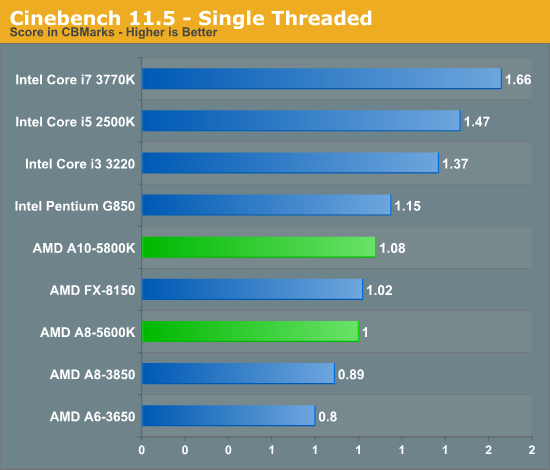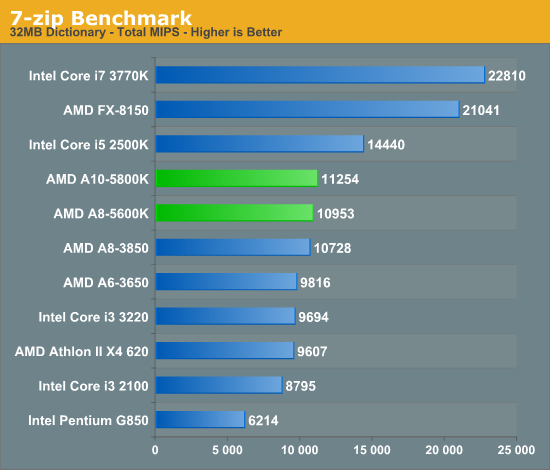AMD A10-5800K & A8-5600K Review: Trinity on the Desktop, Part 2
by Anand Lal Shimpi on October 2, 2012 1:45 AM ESTTrinity CPU Performance: The Good and the Bad
We're going to start our performance investigation a little out of order. The big question on everyone's mind is how much single threaded performance has improved over Bulldozer, and whether it's enough to actually make Trinity faster than Llano across the board. We'll use Cinebench 11.5 as it has both single and multithreaded test options:

The good news is that single threaded performance is definitely up compared to Llano. Piledriver likely has some to do with this, but so does the fact that the A10 can run at up to 4.2GHz (~4GHz typically) with one of its cores active compared to the 2.9GHz clock speed of the A8-3850. Compared to the Bulldozer based FX-8150 there's a slight (~6%) increase in single threaded performance. Although I don't expect anyone will be cross shopping a Trinity APU and a FX CPU, it's important to keep an eye on progress here as we'll eventually get a high-end quad-module/eight-core Piledriver CPU.
Note that compared to even previous generation, low-end Intel CPUs without turbo there's a huge gap in single threaded performance. If we look at the gap AMD has to make up vs. Ivy Bridge it's not pretty. Intel's Core i3 3220 manages a 27% performance advantage over the A10-5800K. Even if Steamroller is able to deliver a 15% increase in performance at the same clock speed, there will still be a gap. And we're not even talking about how Haswell will grow this gap. For the foreseeable future I don't see AMD closing the single threaded performance gap. Jim Keller's job is to fix this problem, but it'll probably take 2 - 3 years to get there.

The multithreaded test shows the other end of reality: in heavily threaded foating point workloads it's possible that we'll see a regression compared to Llano. Remember the Bulldozer/Piledriver architecture prioritizes integer over floating point performance. Truth be told this regression is pretty rare in our tests, but until we get to Steamroller we will still see these types of situations.
Throw more threads at the problem and even with a floating point workload Intel can't pull ahead however. The A10 offers similar performance to the Core i3 3220 at a lower price. Your decision here would come down to the rest of the factors: single threaded performance, processor graphics performance, overclocking capabilities and power consumption. Intel and AMD both win two of those each, it's really a matter of what matters most to you.
A heavily threaded FP workload doesn't really play to AMD's advantages though, what happens when you get a heavily threaded integer workload however? The 7-zip benchmark gives us just that:

Here AMD manages a 16% performance advantage over the Core i3 3220. I'd even go as far as to say that Trinity would likely beat any dual-core Intel machine here. The performance advantage is somewhat artificial as Intel purposefully removes turbo from its dual-core desktop CPUs. This should be AMD's best foot forward, but once again it'll likely take Steamroller for this design to start to make sense.
Speaking of artificial product segmentation, one major feature Intel takes away when you get down to the dual-core desktop i3 level is AES-NI support. Hardware accelerated AES support is something that you get only with the more expensive Core i5/i7s. With Trinity, you get AES-NI support for the entire stack. The result is much better performance in those applications that depend on it:

Like most of the advantages we've talked about thus far, there are really very specific use cases where Trinity makes sense over a similarly priced Intel CPU.










178 Comments
View All Comments
jamyryals - Tuesday, October 2, 2012 - link
On the whole, mainstream consumers do not use desktop PCs. They use laptops.Beenthere - Tuesday, October 2, 2012 - link
Sorry but your beliefs on laptop vs. desktop usage is incorrect. While a lot of young people, sales people etc. use laptops, the split is almost 50/50 according to a recent survey, meaning that ~50% of PC users still use desktops.That being said, Trinity laptop is by far the best choice for mainstream consumers who prefer a laptop over a desktop.
Either way it's a win for AMD and consumers on the desktop or for a laptop. Servers will be next as the AMD APUs have shown excellent results for servers even though they were never intended for same.
silverblue - Tuesday, October 2, 2012 - link
No, but Trinity sports a CPU architecture slanted towards servers. It's not such a strange idea in the end.BSMonitor - Tuesday, October 2, 2012 - link
Could it simply be the priorities of the target customers that so greatly affect how Intel approaches the markets and SKU's??It seems like it would be very easy to grow the die and throw 24-32 EU's on the iGPU side of things. However, what portion of their vast corporate PC market really wants or could use that?? Application developers, end users, small business PCs, etc, etc do not benefit from extra gaming performance or video/encryption performance. Seems to me the market for fast video encoding, high FPS gaming is not this market. Those people buy horsepower. And then, power usage, cost is less important.. This group buys small footprint, low power consumption, and mass quantity..
I think the times for the consumer retail PC space driving revenues are over. And Intel knows this. Retail markets are cheap, cheap laptops, tablets and smart phones..
They cannot completely ignore it, but no one in that space buys "specs". Open Best Buy ad, go buy cheapest PC/laptop/tablet, have a nice day.
AMD is not going to win over corporate markets with high power consumption, better 3D performance APU's... Just like they aren't going to win retail with more features/better specs..
mattlach - Tuesday, October 2, 2012 - link
With IGP's like this, it won't be long before Nvidia is in real trouble.Their high end parts will still sell, but their volume shipments that keep the lights on are in the budget parts, and with better and better IGP's no one is going to need them anymore.
I don't even know what kind of solution Nvidia may come up with for this. They can't design their own desktop/laptop CPU component (or at least this is highly unlikely). It also seems unlikely that they'd get bought up by Intel at this point.
So what is left for them?
Maybe a deal with Cyrix/Via/Centaur (or whatever they are called this week) or ARM or some other minor player?
Exit the desktop GPU market all together and focus on their Tegra/ARM designs?
I can think of a few ways this will go, and none of them are particularly good for the desktop video card market.
jwcalla - Tuesday, October 2, 2012 - link
Hence why they got into the mobile market. NVIDIA had the foresight to see the changes in the market and got in on the ground floor. And while Tegra isn't exactly the best SoC out there, it's won some tablet orders and NVIDIA can always improve it as they go along.At least they're in the game.
Their discrete GPUs will continue to have a presence in the HPC market, and with NVIDIA slapping an ARM co-processor on their GPUs (~2013-'14), I think they'll be even more competitive in that market in the future. And it also allows them to offer an attractive option for any potential console system down the line, or even HTPC devices.
So I think their discrete video card business has to continue to be nurtured even if they lose a bit on the desktop side.
mattlach - Tuesday, October 2, 2012 - link
I agree.I don't think Nvidia will be in trouble of going out of business, but they may be forced out of the desktop GPU market.
Currently, they are able to spread the cost of R&D on a new architecture over low, medium and high end parts. (the chips are not always the same, but the base architecture, where most of the development work goes, is)
If the low end volume parts go away, it becomes tough to see how they continue to maintain profitability on the high end GPU's.
They will always have their mobile market, and it is a good market to be in, but I'm concerned we might be left with only one player in the high end GPU market.
mattlach - Tuesday, October 2, 2012 - link
I'd be interested in building an HTPC around this platform, but I'd want a low power part.It's a little disappointing that there is no sub 65W part.
A desktop version of a mobile trinity part would be perfect for this.
cjs150 - Tuesday, October 2, 2012 - link
That was my thought as well. Intel have an i7-3770T, over priced, way over-powered for an HTPC (and yes I bought one!) but TDP of 45W.AMD need a A10 class chip with a TDP of 35W or less. The move down to 22nm fab cannot come fast enough
jwcalla - Tuesday, October 2, 2012 - link
It really depends on the intended usage of the HTPC. I'm not sure what the deal is with Hulu and Netflix (i.e., if they're CPU bound), but if your usage pattern mostly centers around hardware video decoding, then most of these chips are going to be well overdone.A simple Zotac Zbox w/ Celeron + NVIDIA ION is going to be more than enough (as long as you don't have Hi10p content), and for video decode VDPAU is far more mature than anything I've seen from Intel / AMD at this point.
And within 6 months I'd be looking into ARM-based solutions which should be even cheaper, smaller, quieter and cheaper to upgrade (e.g., when H.265 comes out). (Unless one insists on using non-ARM ported software, like maybe WMC.)